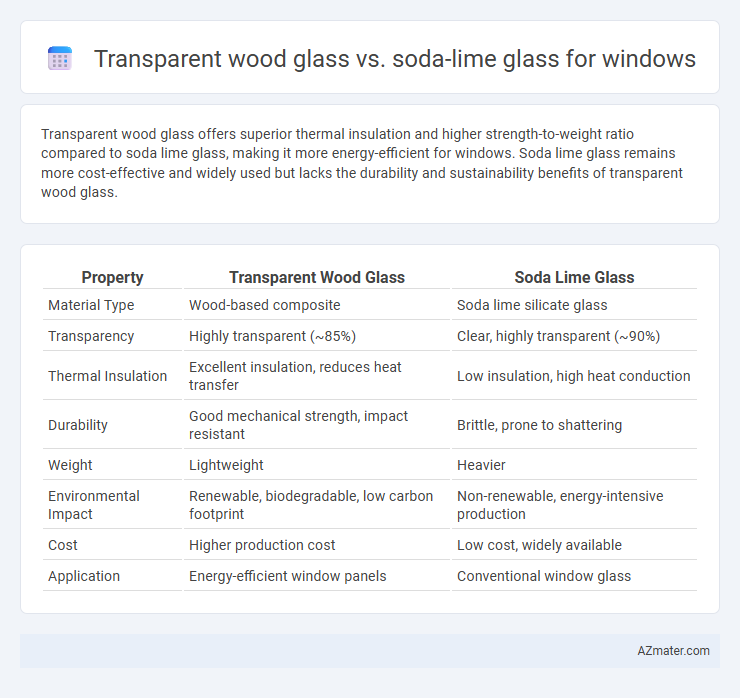Transparent wood glass offers superior thermal insulation and higher strength-to-weight ratio compared to soda lime glass, making it more energy-efficient for windows. Soda lime glass remains more cost-effective and widely used but lacks the durability and sustainability benefits of transparent wood glass.
Table of Comparison
| Property | Transparent Wood Glass | Soda Lime Glass |
|---|---|---|
| Material Type | Wood-based composite | Soda lime silicate glass |
| Transparency | Highly transparent (~85%) | Clear, highly transparent (~90%) |
| Thermal Insulation | Excellent insulation, reduces heat transfer | Low insulation, high heat conduction |
| Durability | Good mechanical strength, impact resistant | Brittle, prone to shattering |
| Weight | Lightweight | Heavier |
| Environmental Impact | Renewable, biodegradable, low carbon footprint | Non-renewable, energy-intensive production |
| Cost | Higher production cost | Low cost, widely available |
| Application | Energy-efficient window panels | Conventional window glass |
Introduction: Evolution of Window Materials
Transparent wood glass demonstrates a significant advancement in window materials by combining wood's natural insulating properties with glass-like transparency, offering enhanced energy efficiency compared to traditional soda lime glass. Soda lime glass, the most common window glass, is favored for its cost-effectiveness and clarity but has limited thermal insulation capabilities. The evolution from soda lime glass to transparent wood glass reflects ongoing efforts to improve durability, sustainability, and energy conservation in modern building design.
What is Transparent Wood Glass?
Transparent wood glass is an innovative material made by removing lignin from natural wood and infiltrating the porous structure with a transparent polymer, creating a lightweight, highly insulating alternative to conventional soda lime glass used in windows. It offers superior thermal insulation and impact resistance compared to soda lime glass, which is a traditional, brittle silica-based material commonly used in window panes. The enhanced energy efficiency and sustainability of transparent wood glass make it a promising replacement for soda lime glass in architectural applications.
Soda Lime Glass: The Industry Standard
Soda lime glass remains the industry standard for window applications due to its cost-effectiveness, durability, and excellent optical clarity. It comprises approximately 70-75% silica, with lime and soda added to enhance stability and workability. Unlike transparent wood glass, soda lime glass offers superior resistance to weathering and thermal variations, making it highly reliable for long-term architectural use.
Optical Clarity: Comparing Light Transmission
Transparent wood glass offers light transmission rates typically ranging from 85% to 90%, providing excellent optical clarity with added benefits like enhanced insulation and UV resistance. Soda lime glass, the most common window material, exhibits light transmission around 90% to 92%, ensuring high optical clarity but with less thermal efficiency compared to transparent wood glass. While both materials allow substantial natural light penetration, transparent wood glass combines optical clarity with superior energy-saving properties, making it a compelling alternative for modern window applications.
Strength and Durability Analysis
Transparent wood glass exhibits superior strength and impact resistance compared to traditional soda lime glass, making it less prone to cracking or shattering under stress. Its unique composite structure combines the natural toughness of cellulose fibers with transparent polymers, enhancing durability while maintaining clarity. Soda lime glass, although widely used, tends to have lower tensile strength and is more vulnerable to mechanical damage and environmental degradation over time.
Energy Efficiency and Insulation Properties
Transparent wood glass offers superior energy efficiency compared to soda lime glass due to its low thermal conductivity and natural insulating properties, reducing heat transfer and lowering heating and cooling costs. Transparent wood's microstructure provides better insulation by trapping air within its porous matrix, enhancing thermal resistance beyond the typical U-value of soda lime glass, which is generally higher in thermal conductivity. This material also exhibits improved thermal stability and maintains transparency, making it an innovative alternative for energy-efficient window applications.
Environmental Impact and Sustainability
Transparent wood glass exhibits a significantly lower carbon footprint compared to traditional soda lime glass, as it utilizes renewable wood fibers and requires less energy-intensive processing. The biodegradable nature and enhanced thermal insulation properties of transparent wood contribute to reduced energy consumption in buildings, promoting sustainable architecture. In contrast, soda lime glass production involves high-temperature melting of raw materials, resulting in higher CO2 emissions and energy use, with limited biodegradability and recycling challenges.
Safety Considerations for Windows
Transparent wood glass offers enhanced safety for windows due to its high impact resistance and reduced shattering risk compared to soda lime glass, which tends to break into sharp fragments upon impact. Its natural polymer matrix improves durability and provides superior resistance to cracks and fractures, making it ideal for environments prone to physical stress or vandalism. In contrast, soda lime glass, while cost-effective, poses higher injury hazards because of its brittle nature and low tolerance to sudden force.
Cost Comparison and Availability
Transparent wood glass, an innovative sustainable material, typically incurs higher production costs than traditional soda lime glass due to complex manufacturing processes and limited large-scale production. Soda lime glass remains economically advantageous and widely available, benefiting from established manufacturing infrastructure and global supply chains. Cost efficiency and accessibility make soda lime glass the preferred choice for most window applications despite the growing interest in transparent wood glass.
Future Outlook: Will Transparent Wood Glass Replace Soda Lime?
Transparent wood glass offers superior thermal insulation and sustainability compared to soda lime glass, making it a promising alternative for energy-efficient windows. Research advancements aim to enhance its mechanical strength and optical clarity to compete commercially with traditional soda lime glass. Given its biodegradability and lower carbon footprint, transparent wood glass is increasingly viewed as a viable future replacement in eco-friendly construction.

Infographic: Transparent wood glass vs Soda lime glass for Window
 azmater.com
azmater.com